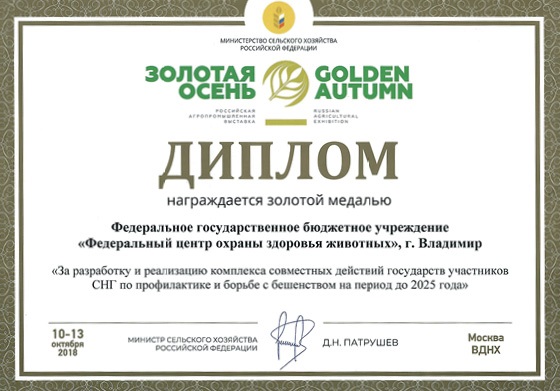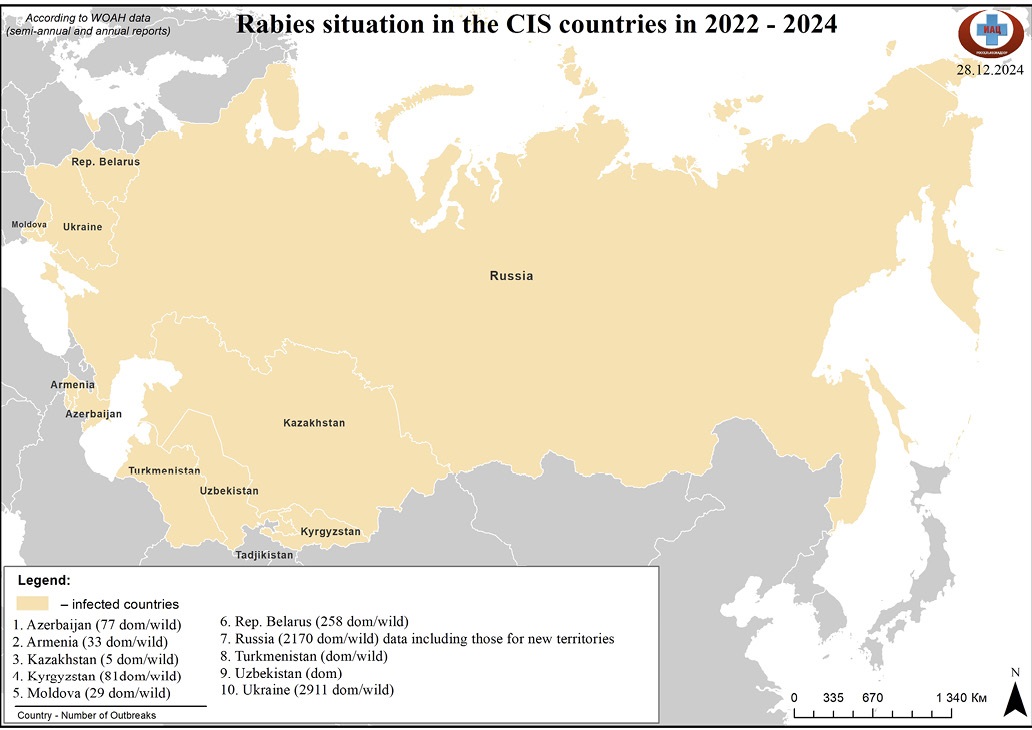Scroll to:
Implementation of the Joint Action Plan by the CIS Members to Prevent and Control Rabies
https://doi.org/10.29326/2304-196X-2025-14-3-218-222
Abstract
Rabies is a fatal viral infection that attacks the central nervous system of mammals, including humans, leading to severe neurological dysfunction. Rabies continues to be a serious concern worldwide, including within the CIS countries. A comprehensive approach is essential to achieve and sustain freedom from rabies. On May 12, 2016, the Intergovernmental Council for Veterinary Cooperation of the Commonwealth of Independent States (CIS) tasked the Federal Centre for Animal Health with developing a draft Joint Action Plan for the CIS Member States on Rabies Prevention and Control, to cover the period through 2025. The set was developed and approved by the decision of the Council of Heads of the CIS Government on June 1, 2018. This paper reviews the implementation results of the Joint Action Plan to 2025 and presents the subsequent plan for 2025–2030, developed with the primary goal of mitigating the risk of rabies outbreak spread throughout the CIS members.
For citations:
Chvala I.A., Chernyshova E.V., Belyakova T.M., Metlin A.Ye. Implementation of the Joint Action Plan by the CIS Members to Prevent and Control Rabies. Veterinary Science Today. 2025;14(3):218-222. https://doi.org/10.29326/2304-196X-2025-14-3-218-222
Rabies is a widespread, often fatal infectious disease reported on all continents except Australia and Antarctica (Fig. 1). It affects the central nervous systems of warm-blooded animals and humans, leading to encephalomyelitis, paralysis, and death.

Fig. 1. Global rabies situation as of December 30, 2024
Although the disease has been eradicated in some European countries, it remains a serious problem across much of Eurasia, Africa, and the Americas. According to the World Health Organization (WHO), approximately 70,000 people die from rabies annually in over 150 countries, with 95% of these cases concentrated in Africa and Asia. This disparity is due to a lack of awareness about rabies and limited or absent access to essential preventive measures. The disease is reported in both wild carnivores and domestic animals, being the main reservoir of the virus. Asian countries hold the lead in the number of human and animal rabies cases. International conferences are organized for World Rabies Day (September 28) to facilitate the exchange of data on infection control, diagnostic methods, and up-to-date information on related drugs. In 2024, the Federal Centre for Animal Health hosted an international scientific and practical conference “Breaking Rabies Boundaries” within the framework of a four-party partnership between WHO, the World Organization for Animal Health (WOAH), the Food and Agriculture Organization of the United Nations (FAO) and the United Nations Environment Programme (UNEP), dedicated to this day. The conference was attended by Thanawat Tiensin, FAO Assistant Director-General, and Chief Veterinarian; Oleg Kobiakov, the Director of Liaison Office with the Russian Federation; Batyr Berdyklychev, Head of the WHO Country Office in the Russian Federation; Vladimir Moshkalo, Head of the UNEP Regional Office in the Russian Federation; and Budimir Plavsic, Head of the WOAH Regional Representation for Europe in Moscow. The conference brought together more than 400 participants, including experts from international organizations, leading veterinary specialists from Russian institutions, government officials, and members of the public. Based on the conference outcomes, experts established a rabies control strategy centered on three key components: public awareness campaigns, managing stray animal populations via mandatory pet identification, and the widespread vaccination of cats and dogs.
The animal rabies situation is tense in many countries bordering Russia, such as Belarus, Azerbaijan, Kazakhstan, Mongolia, and China. The Baltic countries successfully eliminated rabies a few years ago through an intensive, large-scale oral vaccination campaign. This approach has since served as an effective model for nations in the Balkan Peninsula, such as Slovenia, Croatia, Serbia, North Macedonia, Montenegro, Albania and Bulgaria, which are now also exemplary cases of disease eradication. Through comprehensive programs focused on vaccination, monitoring, and surveillance, they have successfully eradicated rabies within their territories. Thanks to strict epizootic surveillance, these countries have reported no major outbreaks for many years, with only isolated, imported cases of rabies occurring.
The global increase in dog rabies cases is amplifying the role of dogs as a viral source, directly endangering human health. In response, the Russian Federation, as a member of the WHO, WOAH, and FAO, is taking steps to meet the goals of a 2030 global initiative to eliminate dog-mediated human rabies. This initiative, launched at the 2015 International Conference on Rabies, requires action in research, policy, and practical areas. The Russian Federation’s first steps began in 2000 when the Veterinary Department of the Ministry of Agriculture Russia designated the All-Russia Research Institute for Animal Health (now the Federal Centre for Animal Health) as the national diagnostic center for rabies testing by Order No. 32 on October 19, 2000. Through this order, the Federal Centre for Animal Health was entrusted with the responsibility of monitoring the epizootic situation and was granted the authority to submit proposals for enhancing diagnostic methods, pharmaceuticals, and preventive measures for rabies in domestic and wild animals. The decision of the Intergovernmental Council for Veterinary Cooperation of the Commonwealth of Independent States (CIS) of May 12, 2016 tasked the Federal Centre for Animal Health with developing a draft Joint Action Plan for the CIS Member States on Rabies Prevention and Control, to cover the period through 2025 (hereinafter referred to as the Joint Action Plan). It was determined that a sustainable, rabies-free status and a reduction in economic losses require an integrated approach, encompassing the development of diagnostic protocols, evaluation of immunization efficacy, large-scale molecular research in Russia and in the CIS neighboring states, and analysis of vaccine strain properties. Addressing these tasks requires active international cooperation through the exchange of experience, knowledge, and the pursuit of joint research. The Joint Action Plan was developed and approved by the decision of the CIS Council of Government Heads on June 1, 2018. This decision was signed by the Governments of the Republics of Armenia, Belarus, Kazakhstan, Tajikistan, Uzbekistan, Kyrgyzstan and the Russian Federation.
For the development of the Joint Action Plan, the Federal Centre for Animal Health was awarded the gold medal of the Golden Autumn contest in 2018 (Fig. 2).

Fig. 2. Golden Autumn 2018 Diploma
During the implementation of the 2018–2025 Joint Action Plan, all CIS members took significant steps to combat rabies. These included developing and executing national control plans, conducting diagnostic tests on wild and domestic animals, and accrediting laboratories to the GOST ISO/IEC 17025-2019 standard. Furthermore, countries assessed the epizootic situation, carried out preventive immunization, and monitored immune status. These comprehensive measures have been instrumental in advancing disease freedom, reducing infection risk for humans and animals, and minimizing the economic impact of the disease.
The work of the Federal Centre for Animal Health has also been crucial to rabies control successes. As the CIS’s designated training organization, the Federal Centre for Animal Health enhances the skills of veterinary specialists from member states in modern rabies diagnosis, prevention, and control.
Several countries have established a reserve stock of essential veterinary drugs to control infectious diseases. This stock, which includes rabies vaccines and immunoglobulins for public immunization, supports measures for prevention, diagnosis, outbreak response, and treatment. Laboratories involved into rabies diagnostics participated in interlaboratory comparison tests on a regular basis.
Scientific research into the molecular epidemiology of rabies involved creating and replenishing a national collection of field isolates. Analysis confirmed the absence of vaccine strains among these isolates, demonstrating the safety of the rabies vaccines in use.
The knowledge gained from this accumulated experience was disseminated annually through open-source publications (scientific journals, collections of papers, conference proceedings) and presentations at international conferences, roundtables, webinars and seminars.
The veterinary services of the CIS members consistently informed the public about rabies prevention and bite response protocols through articles, informational leaflets, and website postings.
To summarize the results of the Joint Action Plan implementation, the CIS Executive Committee sent letters to the CIS governments. Responses were received from the Republics of Armenia, Belarus, Kazakhstan, Tajikistan, Uzbekistan, the Kyrgyz Republic and the Russian Federation.
A review of reports from CIS member states indicates that the rabies epizootic situation remains tense (Fig. 3). Despite this, the implemented measures have yielded significant results, including a reduction in animal rabies cases and the prompt execution of laboratory diagnostics and animal health measures as outlined in the Joint Action Plan.

Fig. 3. Rabies situation in the CIS members as of December 28, 2024
This work has established a long-term foundation for effective rabies prevention and control cooperation among the CIS members. These results provide a foundation to continue working consistently toward rabies freedom and eventual eradication throughout the CIS. Although the territories of the CIS members remain infected due to their natural geography, the work done in recent years has had a positive impact.
Since rabies remains a serious problem in the CIS and the current Joint Action Plan ends in 2025, the Intergovernmental Council for Veterinary Cooperation has endorsed a proposal by the Federal Centre for Animal Health to extend the plan to 2030. The proposal emphasized the need to strengthen the close cooperation among the CIS members to achieve and maintain rabies freedom in each state and across the Commonwealth.
Draft Joint Action Plan for 2025–2030 developed by the Federal Centre for Animal Health was discussed in October 2024 at the 46th regular meeting of the Intergovernmental Council for Veterinary Cooperation in Turkmenistan (Ashgabat) and approved by the representatives of the CIS Veterinary Services. In the period from January 31 to February 21, 2025, the CIS Executive Committee office (Moscow) approved it at expert group meetings and on July 18, 2025, it was approved at a meeting of the CIS Economic Council. The approval of the Joint Action Plan is on the agenda of the meeting of the Council of Government Heads on September 30, 2025.
The Joint Action Plan for 2025–2030 builds upon foundational CIS veterinary safety documents, maintaining continuity with the goals, objectives, and cooperative frameworks established in the previous plan up to 2025. The plan incorporates proposals from the CIS Veterinary Services, recommendations from international organizations, and lessons learned from rabies control programs in the EU, US, and Canada. Furthermore, the new Joint Action Plan reflects the core principles of the “Zero by 30” strategy. This strategy is underpinned by a Tripartite Memorandum of Understanding between the WHO, FAO, and WOAH, which guides countries in developing national rabies eradication plans through a One Health and intersectoral cooperation framework.
The main goal of the Joint Action Plan for 2025–2030 is to work towards the eradication of dog-mediated rabies in CIS members by minimizing the risk of outbreaks and their spread.
The implementation of the Joint Action Plan on Rabies Prevention and Control through 2030 will enable the CIS members to develop national strategies to stop rabies circulation among domestic and stray carnivores, primarily dogs; to continue veterinary measures that reduce rabies incidence in wild carnivore populations; to strengthen veterinary services in fulfilling the requirements of Article 8.15 of the WOAH Terrestrial Animal Health Code and to minimize the risk of human rabies infections.
About the Authors
I. A. ChvalaRussian Federation
Ilya A. Chvala - Cand. Sci. (Veterinary Medicine), Deputy Director for Research, Federal Centre for Animal Health.
6 Gvardeyskaya str., Yur’evets, Vladimir 600901
E. V. Chernyshova
Russian Federation
Elena V. Chernyshova - Cand. Sci. (Veterinary Medicine), Head of Reference Laboratory for Rabies and BSE, Federal Centre for Animal Health.
6 Gvardeyskaya str., Yur’evets, Vladimir 600901
T. M. Belyakova
Russian Federation
Tatiana M. Belyakova - Advisor to the Department of Sectoral Economic Cooperation of the Department of Economic Cooperation of the CIS Executive Committee.
34/1 Sofiyskaya Embankment, Moscow 115035
A. Ye. Metlin
Italy
Artem Ye. Metlin - Dr. Sci. (Veterinary Medicine), Food and Agriculture Organization of the United Nations.
Viale delle Terme di Caracalla, Rome 00153
Review
For citations:
Chvala I.A., Chernyshova E.V., Belyakova T.M., Metlin A.Ye. Implementation of the Joint Action Plan by the CIS Members to Prevent and Control Rabies. Veterinary Science Today. 2025;14(3):218-222. https://doi.org/10.29326/2304-196X-2025-14-3-218-222



































